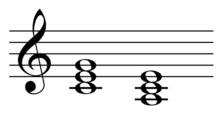Tonic parallel

Tonic and tonic parallel in C major: CM and Am chords  Play .
Play .
In music theory, the tonic parallel (relative chord, German: Parallelklang) is a diatonic function and chord, relative to the tonic, and thus considered to have or fulfill the function of the tonic.[1] The term is used in German theory and derives from the work of Hugo Riemann. It is abbreviated "Tp" in major and "tP" in minor.

Tonic and tonic parallel in C minor: Cm and E♭M chords  Play .
Play .
Dr. Riemann...sets himself to demonstrate that every chord within the key-system has, and must have, either a Tonic, Dominant or Subdominant function or significance. For example, the secondary triad on the sixth degree [submediant] of the scale of C major, a-c-e, or rather c-e-a, is a Tonic 'parallel,' and has a Tonic significance, because the chord represents the C major 'klang,' into which the foreign note a is introduced. This, as we have seen, is the explanation which Helmholtz has given of this minor chord."— Shirlaw 2010[2]
In C major:
- Tp is A-minor, US submediant
In C minor:
- tP is Eb-major, US mediant
See also
Sources
This article is issued from Wikipedia - version of the 12/18/2013. The text is available under the Creative Commons Attribution/Share Alike but additional terms may apply for the media files.
